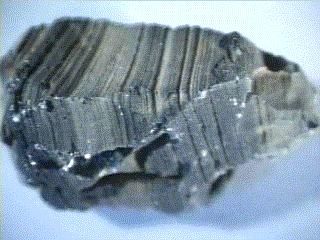|
Igneous rocks are one of the three major rock types and are basically rocks that solidified from magma. Magma is the term for liquid or melted rock and is usually quite hot. After all, the term igneous comes from the Latin word for "of fire". Most people have seen pictures or video of magma that flows out of a volcano. When magma flows onto the surface of the Earth it is called lava. When the lava cools and forms a rock, that rock is an igneous rock. But there are also rocks that form from magma that does not reach the surface of the Earth. These rocks form in what are often called plutons and are also types of igneous rocks. These two types of igneous rocks are called extrusive (because it extruded or came out of the Earth) and intrusive (because it intruded and stayed inside the Earth). They are also referred to respectively as volcanic and plutonic. Classifying igneous rocks into these two main types is easy and logical for the most part. If the rock formed from lava spilling onto the surface of the rock then it is an extrusive or volcanic igneous rock. If the rock never made it to the surface before it cooled into a rock, then it is an intrusive or plutonic igneous rock. Easy right? Well, further classification of igneous rocks is a bit more complicated. Another classification technique uses the mineral components of
the rock and is called the modal method of classification. Identification
of the rock's minerals is of course important and is easy to do when the
minerals are found in large crystals and can easily be identified. This method
has "official" approval and is generally what petrologists use to classify
rock samples. When the crystals are too small to be seen without a microscope,
then true identification becomes a problem in the field. Generalized
terms used in this classification technique include felsic, intermediate,
mafic and ultramafic. Felsic rocks, similar to acidic rocks, contain
a lot of silica, sodium and calcium and form
quartz and
feldspar minerals; felsic is short for feldspar/silica.
Mafic, similar to basic rocks, have
a lot of magnesium and iron (ferrous) and is short for magnesium/ferrous.
Generally the important aspect of this classification is the ratio of three
minerals and tertiary diagrams are used to classify the rocks. In rocks
that contain feldspars and quartz then the ratio of quartz to plagioclase
feldspars to calcium or alkali feldspars is used. For example, an igneous
rock that has around 50% quartz to 25% plagioclase and 25% alkali feldspar
is classified as granite. The boundaries between rock names are arbitrary
and a classification diagram is necessary. Ultramafic rocks which generally
do not have many quartz or feldspar minerals are classified based on their
percentages of olivine,
pyroxene and
hornblende.
Feldspathoid rocks which
do not have quartz are classified based on their plagioclase feldspar/alkali
feldspar/feldspathoid percentages.
Calcite can be the predominant mineral
in a special case of igneous rock and then the rock is classified as a
carbonatite. A third general type of classification uses a variety of characteristics and is therefore more subjective, but sometimes easier to use for the average rock hound. It involves the use of the rocks texture, color and mineralogy. Although not an official classification technique, it nevertheless produces a field-identifiable way to classify igneous rocks. Rocks are divided by their texture from glassy to fine grained (aphanitic) to course grained (phaneritic). The terms such as fragmented, vesicular (having a lot of holes), porphoritic (large crystals in a glassy or fine grained matrix) and pegmatitic (all crystals are large) are used to further describe the texture. After texture is applied, color comes into play. Generally the rock is described from light to dark in color. Finally the mineralogy is applied if known. This is generally used for rocks that contain a large amount of one particular mineral such as calcite for carbonatite or anorthite for anorthosite. Using this technique is easier, but leads to misidentifications and is not useful for scientific analysis. But at least we generally know what igneous rock we are looking at. And isn't that the purpose of classification anyways? Below are the main types of igneous rocks and their general attributes
that place them into the various classification schemes:
|

